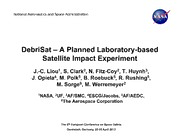
NASA Technical Reports Server (NTRS) 20130012445: DebriSat - A Planned Laboratory-Based Satellite Impact Experiment PDF
Preview NASA Technical Reports Server (NTRS) 20130012445: DebriSat - A Planned Laboratory-Based Satellite Impact Experiment
NNaattiioonnaall AAeerroonnaauuttiiccss aanndd SSppaaccee AAddmmiinniissttrraattiioonn DebriSat – A Planned Laboratory-based Satellite Impact Experiment J.-C. Liou1, S. Clark2, N. Fitz-Coy2, T. Huynh3, J. Opiela4, M. Polk5, B. Roebuck5, R. Rushing5, M. Sorge6, M. Werremeyer2 1NASA, 2UF, 3AF/SMC, 4ESCG/Jacobs, 5AF/AEDC, 6The Aerospace Corporation The 6th European Conference on Space Debris Darmstadt, Germany, 22-25 April 2013 National Aeronautics and Space Administration Motivations (1/2) • Collision fragments are expected to dominate the future orbital debris environment • A higher fidelity breakup model to describe the outcome of satellite collisions is needed for – Good orbital debris environment definition – Reliable short- and long-term impact risk assessments (from debris as small as 1 mm) for critical space assets • Laboratory-based satellite impact tests are necessary to characterize fragments smaller than 10 cm – Size, mass, area-to-mass ratio, shape, composition, optical/radar properties, etc. 2/13 National Aeronautics and Space Administration Motivations (2/2) • As new materials and new construction techniques are developed for modern satellites, there is a need to conduct additional laboratory-based tests and use the data to further enhance the existing breakup models A/M Comparison (fragments between 10 and 20 cm) 500 Fengyun-1C 450 FY-1C fragments (5/17/2010 data) 400 NASA model 350 Iridium 33 300 r e b 250 m u N 200 150 100 50 0 -3 -2.5 -2 -1.5 -1 -0.5 0 0.5 1 1.5 2 Log (A/M m2/kg) 10 NASA model predictions match well with fragments generated from old satellites, but are noticeably different from fragments of more modern satellites (left: FY-1C, right: Iridium). 3/13 National Aeronautics and Space Administration Roles and Responsibilities of the Team • NASA Orbital Debris Program Office – Co-sponsor, project and technical oversight, data analyses, NASA model improvements: J.-C. Liou, J. Opiela • AF Space and Missile Systems Center (SMC) – Co-sponsor, technical oversight, data analyses, DoD model improvements: T. Huynh, M. Sorge • University of Florida (UF) – Design and fabrication of DebriSat, post-impact fragment characterization: N. Fitz-Coy, S. Clark, M. Werremeyer • AF Arnold Engineering Development Complex (AEDC) – Hypervelocity impact: R. Rushing, M. Polk, B. Roebuck 4/13 National Aeronautics and Space Administration A Key Test from the Past • A key laboratory-based test, SOCIT*, supporting the development of the DoD and NASA satellite breakup models was conducted in 1992 – Target satellite: A U.S. Navy Transit navigation satellite • Dimensions and mass: 46 cm (dia) × 30 cm (ht), 34.5 kg • No Multi-layer Insulation (MLI) • Was built in the early 1960’s • Was selected because of its availability – Projectile: 4.7 cm diameter Al sphere – Impact speed: 6.1 km/sec – Post-test analysis • Only ~10% of the fragments were measured (4761 in total) Many were sieved and bagged together (up to 260 per group) to estimate the average properties of the groups • The results were scaled up by a factor of 10 to represent the distribution of the entire fragment set *SOCIT: Satellite Orbital debris Characterization Impact Test 5/13 National Aeronautics and Space Administration DebriSat versus Transit • DebriSat has a modern design and is 45% more massive than Transit • DebriSat is covered with MLI and equipped with solar panels Transit / SOCIT DebriSat Target body dimensions 46 cm (dia) × 30 cm (ht) 60 cm (dia) × 68 cm (ht) Target mass 34.5 kg 50 kg MLI and solar panel No Yes Projectile material Al sphere Al sphere Projectile 4.7 cm diameter, 150 g 5 cm diameter, 176 g dimension/mass Impact speed 6.1 km/sec 7 km/sec Impact Energy to Target 78 J/g 86 J/g Mass ratio (EMR) 6/13 National Aeronautics and Space Administration DebriSat Design (1/4) • DebriSat is intended to be representative of modern LEO satellites – A survey of recent LEO payloads was conducted – 50 satellites were selected for analysis – Common subsystems, materials, mass fractions, structure, and construction methods were identified – Major design decisions were reviewed and concurred by subject matter experts from different disciplinary areas 7/13 National Aeronautics and Space Administration DebriSat Design (2/4) Deployable Composite Solar Panels Panel Panel D 90 cm Bay 4 Bay 3 Bay 5 Bay 7 50 cm Bay 2 Bay 6 50 cm Bay 1 Panel A 30 cm Nadir Panel Optical Payload 8/13 National Aeronautics and Space Administration DebriSat Design (3/4) • DebriSat includes 7 major subsystems – Attitude determination and control system (ADCS), command and data handling (C&DH), electrical power system (EPS), payload, propulsion, telemetry tracking and command (TT&C), and thermal management – Each system contains standard components, such as star trackers, reaction wheels, flight computer, data recorder, thrusters, antennas, avionics boxes, heat pipes, harnesses, etc. – To reduce cost, most components are emulated based on existing design of flight hardware and fabricated with the same materials Reaction wheel Emulated Magnetorquer Emulated (Credit: Sinclair reaction wheel (Credit: Sinclair Magnetorquer Interplanetary) (CAD drawing) Interplanetary) (CAD drawing) 9/13 National Aeronautics and Space Administration DebriSat Design (4/4) Component Identification 1–FlightComputer 13 – TelemetryAvionics (2) 2–DataRecorder 14 – Fill Drain Valve 3–ReactionWheel(4) 15–StarTracker(2) 4–X‐BandConicalFeedHornAntenna 16–SunSensor(4) 5–OpticalImager 17–PayloadSupportModule 6–Solenoids(3) 18–Magnetometer 7–PowerConditioningandDistribution 19–ADCSAvionics 8–Spectrometer(2) 20–S‐BandHelicalAntenna 9–ThermalReservoir 21–Propulsion Avionics 10–Omni‐DirectionalAntenna(2) 22–Magnetorquer(3) 11–COPV 23–Inertial Measurement Unit 12–Li‐ionbatterybox(3) 24–Thrusters(6) Bay 1 Bay 2 Bay 3 Bay 4 Bay 5 Bay 6 Bay 7 24 24 24 24 14 16 3 3 9 21 12 12 12 1 6 6 19 16 22 22 7 13 3 22 17 5 16 16 18 11 2 13 23 8 8 3 24 24 4 20 15 15 10 10/13
